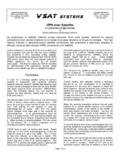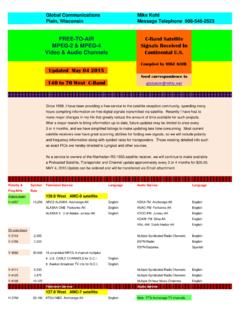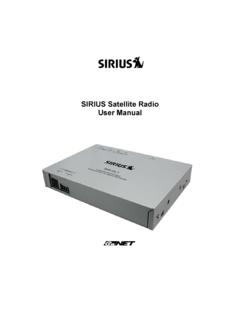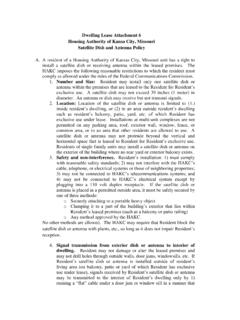Transcription of The “Grey Nomad’s” Guide to Satellite Dish Setup …
1 1 The Grey Nomad s Guide to Satellite dish Setup procedures . Compiled and written by Ronald H Tew of The Wandering Tews Issue 10, 7th December 2010. Web site: 2 About this Document. It is hopeful that this document may give an idea of setting up a Satellite dish to receive OPTUS C1 signals. It will also give some information on activating an Aurora Smartcard. It should be noted that the unit used to receive Satellite signals will sometimes be referred to as a Set Top Box and sometimes as a Decoder Box. Either of these terms can be used. My Satellite History. I have regularly used the following procedure to set up my Satellite dish in various locations and have had no trouble at all in getting a signal. I have a web site, , on which this document and other normal TV reception information is available for free download. See the TV Reception page on the site. Feedback on this information would be greatly appreciated, contact me via the web site.
2 Purchasing a Satellite system. I am not going to make any recommendation for any system, as I found that most pre-configured systems had some bad points, eg cost or some equipment I was not happy with, then I was also a novice. I basically bought parts to configure my own system, but I appreciate not all have the technical experience to be able to do that. It may be taking a bit of a chance with which ever system is purchased, but I do stress that there might not be anything wrong with any system that is on the market for the average user. It must be stressed at this point that there are a few things and points of information you must obtain from the place of purchase. They must provide all leads and tuning meter. Get all information about getting an Aurora smartcard so one can receive coded transmissions, not all normal free to air channels are readily accessible. (The test channel on Optus C1 gives details on where to purchase a card if not supplied.)
3 Find out from them how one goes about getting access to coded transmissions (activating the Smartcard), fax forms could be required. Bearing in mind that the procedure is different for receiving channels for WA than it is for the rest of Australia. (Rough details are provided later.) See if they have information about bearings, elevation, LNB Skew and Setup procedures , if they have it may be more suitable than mine.(See my web site for a list of these.) Remember if one intends camping out without 240 volt power and intend using Satellite , a 12 volt unit could be very handy. Channels received. Some sales people will tell you that you will receive ABC, SBS, 7, 9 and 10, this is not strictly true. ABC and SBS yes, but the other stations, such as Imparja and Central 7 for eastern Australia, and GWN and WIN in WA, are primarily 7 or 9, but sometimes show programmes from 10.
4 There is no channel 10 as such. (Check out another booklet called VAST Satellite Digital TV as this is a new system commencing in June 2010. This info will ultimately be placed in this document.) 3 Theory. There are quite a number of Satellites in the sky, located at different positions around the earth. These satellites are always in the same position in relation to the earth, so once a dish is tuned into a particular Satellite while in any particular location the dish never needs moving whilst in that same location. The Satellite the Grey Nomad is likely to use in Australia is Optus C1 , which is located somewhere above Papua New Guinea. Elevation. A Earth position B C The Sketch above shows the relationship between Satellite Optus C1 and three different locations within Australia, A is further south than B or C. One can see that position A requires a lower Elevation than positions B or C, so it can be seen that depending on ones location in relation to north and south the elevation will vary, being higher the further north one is.
5 Compass Bearings. From the map of Australia above one can see that wherever one is in relation to east and west the compass bearing will vary to point at the Satellite . In WA one would have to point the dish further toward east, or further from North, than in SA or NSW. Satellite Optus C1 Elevation Satellite Optus C1 North N E W 4 LNB skew The angle of rotation of the LNB within its clamp. The polarization angle of the LNB must be aligned with that of the Satellite . This angle is set by means of the scale on the LNB, as shown in the example at right. The LNB skew will vary in relation to being east or west within the country. This adjustment does not effect the dish tuning levels, rather than the individual channel levels seen on the info bar when changing channels. A Tip to remember which direction is +ve or ve: If there are no markings on the LNB, generally with the cable pointing directly downward the LNB will be at zero.
6 Standing in front of the dish , with the LNB on the centre mark, turning the LNB Clockwise is to the +ve direction. Standing in front of the dish , with the LNB on the centre mark, turning the LNB Anti-Clockwise is to the -ve direction. Anti meaning ve. Note: I have now come across an LNB that does not strictly adhere to the above rules, so be careful, you may have one of these. The brand was a SWISS, and the sticker on the unit with degree markings did not agree with the above. In Melbourne to get a signal the unit was set at approx. 0 degrees, according to the markings, and the cable was at the 35 Degrees position in reference to the above explanation. Given these discrepancies I can only conclude that some LNB s differ from the above explanation, and if this is your case then you will have to experiment to find the correct position wherever you may be in the country.
7 Tuning meter. One of the easiest methods of tuning a dish is with a tuning meter, they do come in analogue and digital, and for now I will describe the use of an analogue meter. I would recommend the use of a digital meter as they are easier, but more expensive to purchase. The meter has to be installed in line with the aerial lead as shown on the connectors, and close to the dish so one can watch the meter while adjusting the dish . The Satellite decoder box must be turned on and all aerial leads must be connected as the decoder box provides power for the LNB and the meter. The meter actually reads a test signal from the Satellite so the stronger the test signal the closer the dish is tuned in. The test signal is also the same from all satellites so bear in mind you can sometimes actually tune into the wrong Satellite , resulting in no picture. If this occurs recheck the compass bearing and elevation and restart from that point.
8 5 Procedure. Below is a chart consisting of an outline map of Australia, several black arcs traversing across the map and several red and green lines traversing from roughly north to south on the map. This map can be used as a rough Guide for required figures. The Black arcs represent the elevation that is required at different locations. The Red lines represent the compass bearing that is required at different locations. The Green lines represent the LNB skew that is required at different locations. Following this chart all one has to do is pin point their location within our great land, then the compass bearing, LNB position and elevation can be worked out reasonably accurately, although this chart is not known to be exactly correct, but is close. Another document on my web site contains a list of these details for many individual towns/cities. 6 My Tuning method.
9 1. Make sure all cables are connected, including the tuning meter. Turn on the Set Top Box, and tune to channel 1, the info channel, and turn the TV volume up loud enough to hear at the dish position. This will allow you to know when Optus C1 has been found by hearing the test tone on that channel. a. Do not turn on the STB until all cables are connected. 2. After determining the compass bearing required I place my dish stand on the ground with one leg pointing in the direction of the compass bearing. This then allows me to have an easy reference point when the dish is mounted on the stand. a. It is important to note at this stage that the dish stand must be level with the upright as close to vertical as possible. 3. Position the LNB Skew as per details provided. 4. Most, if not all, dishes will have elevation markings on the adjustment area of the frame work. Determine the elevation required and adjust the dish height according to the markings.
10 5. At this stage leave all adjusting bolts slightly loose as you will have to move the dish both sideways and up-and-down, but they must be tight enough not to allow any stray movement. 6. Remember never stand in front of the dish while tuning, you will block the signal. 7. Turn the volume control on the meter up till a mid range reading is shown on the meter. a. Turn the dish left and, or, right slowly by a few degrees only at a time until an increase in the meter level occurs. b. If the Satellite can t be found, lift the dish elevation up, or down, a few degrees, return to original compass bearing and start again. c. When the meter reading level goes off the top range wind the volume control down until a mid rage reading is once again shown. d. Continue to move the dish left or right slightly, repeating steps c. and d. several times until the maximum possible reading is received.








